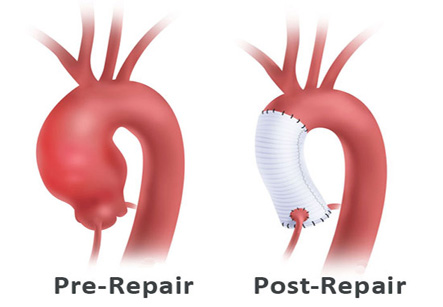Bentall Procedure
Introduction
A Bentall procedure is a cardiac surgery which involves composite graft replacement of the damaged aortic valve, aortic root and ascending aorta, along with re-implantation of the coronary arteries into the graft. This operation is utilised to treat diseases involving both the aortic valve and ascending aorta. This can include lesions associated with Marfan’s syndrome. The Bentall procedure was first described in 1968 by Hugh Bentall and Antony De Bono.
The Bentall surgery entails replacement of the aortic valve, aortic root and ascending aorta. However, if all the three components are not involved; other operations may be used.
• Normal aortic root: in this case, the re-implantation of the coronary arteries is prone to complications and aortic root replacement should be avoided if possible. Usually the aortic valve and ascending aorta are replaced in separate steps, without root replacement.
• Normal aortic valve with annular dilation and ascending aneurysm – this is frequently found in Marfan syndrome. Artificial heart valves may wear out or require life-long anticoagulation. A valve-sparing aortic root replacement allows the replacement of the aortic root and/or ascending aorta. This surgery allows preservation of the own aortic valve for the patient and avoids the problems of aortic valve replacement.
Iran is among the top 10 countries in treating cardiovascular diseases, while it ranks first in the Middle East

Procedure
A Bentall procedure is a type of surgical procedure usually performed as a part of open heart surgeries that concerns the aorta, the largest artery of the heart. This can involve replacing some defective parts of the aorta such as the valve or the upper part called as the ascending aorta, with a graft. Some patients with Marfan syndrome may especially need to undergo a Bentall procedure. This condition causes either a regurgitation of a heart valve or a bicuspid aortic valve (instead of the normal tricuspid valve). The procedure may need to be performed in cases of aneurysms. In aneurysm, the ascending aorta balloons out and surgery is needed to prevent the aorta from rupturing and causing a fatal hemorrhage.
This technique was first achieved by sewing and wrapping the coronary arteries around the valve replacement. This was done using a method called as side to side anastomosis. This means that the incision made on the artery is a lengthwise incision for grafting it on the valve replacement. This method, however, resulted in further aneurysms after surgery. The surgery has been modified several times since then. The current and most common type of Bentall procedure used by surgeons is called as the “button” procedure.
After an incision in the chest area is performed, the heart is put under a cardioplegia. This means stopping of any heart activity, so that no bleeding will occur and surgeons can perform the operation properly in a bloodless, motionless field. The part of the aorta that needs to be replaced is excised, and two coronary “buttons” opposite each other are dissected from the wall of the aorta. The valve replacement tube is then connected to the aorta using surgical needles and threads called as sutures. After stitching the valve replacement, the surgeon will create two holes in the tube. Previously dissected coronary buttons are sewn in these holes. This method will help to snugly secure the valve replacement in the aorta.
This technique was first achieved by sewing and wrapping the coronary arteries around the valve replacement.
In between the surgical steps, the surgeon often tests if the valve is properly secured on the aorta by streaming some blood into the valve area and making sure that there is no leakage from the stumps. Under normal circumstances, the Bentall procedure requires about 5 hours for completion. Many studies have shown that most of patients who went through the procedure survived even after ten years. After this period, the valve may need to be replaced with a new one. However, regular visits to the cardiologists are required to make sure that the valve is working properly.
For ascending aortic aneurysms associated with an abnormal aortic valve, the operation involves removal of both the ascending aorta and the aortic valve. In this so called Bentall Operation, the aortic valve as well as ascending aorta is replaced with a Dacron graft with an attached prosthetic aortic valve. In this operation, the coronary arteries are also removed from the aorta and re-attached to the new aortic graft.